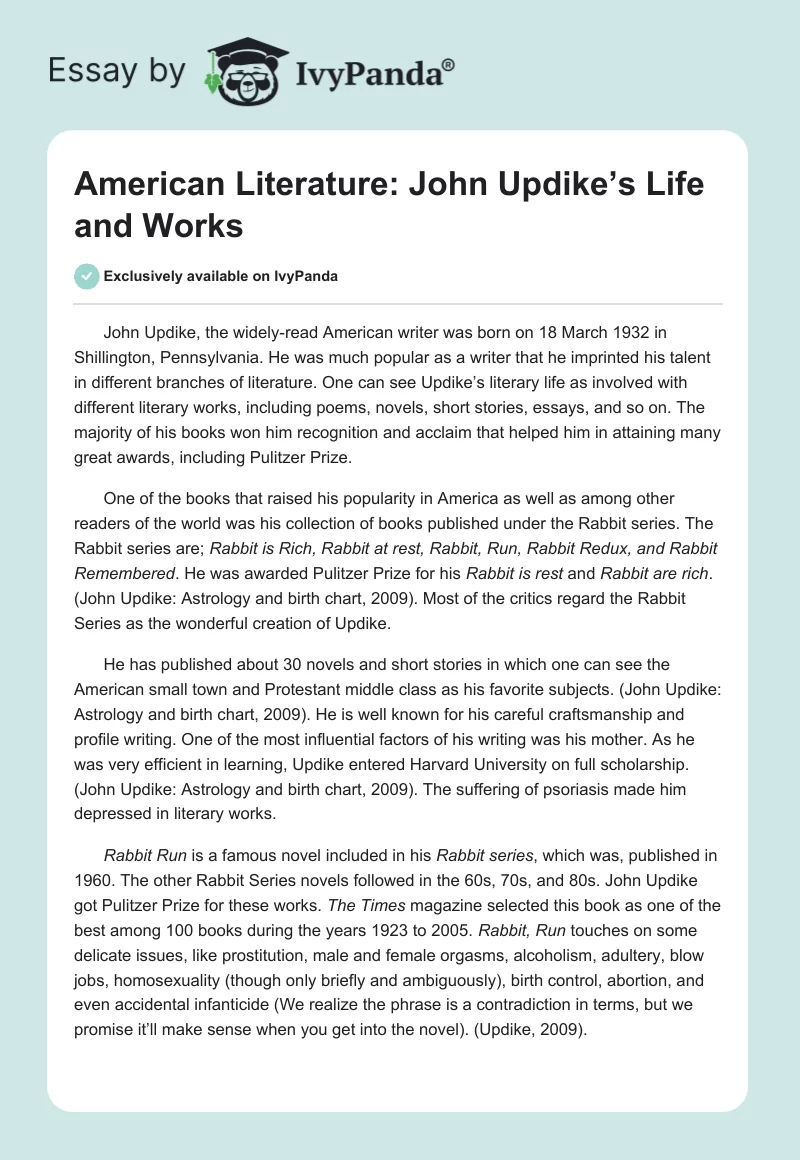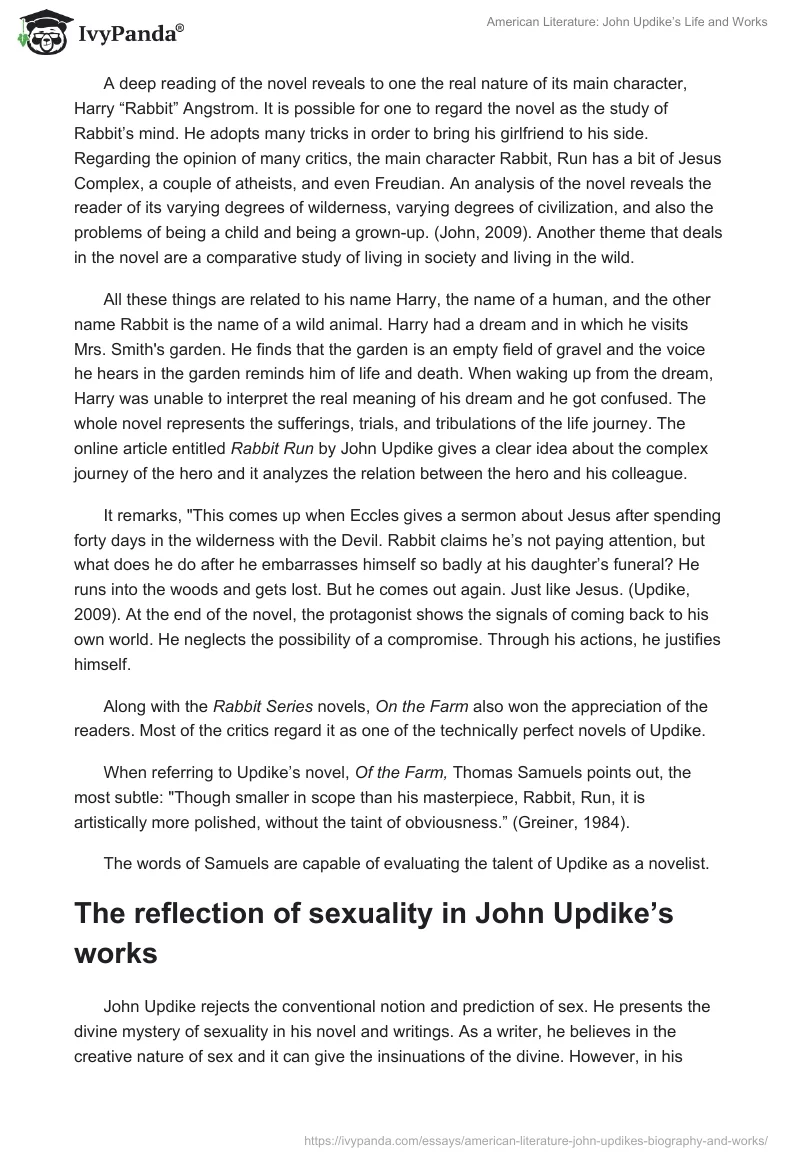John Updike, the widely-read American writer was born on 18 March 1932 in Shillington, Pennsylvania. He was much popular as a writer that he imprinted his talent in different branches of literature. One can see Updike’s literary life as involved with different literary works, including poems, novels, short stories, essays, and so on. The majority of his books won him recognition and acclaim that helped him in attaining many great awards, including Pulitzer Prize.
One of the books that raised his popularity in America as well as among other readers of the world was his collection of books published under the Rabbit series. The Rabbit series are; Rabbit is Rich, Rabbit at rest, Rabbit, Run, Rabbit Redux, and Rabbit Remembered. He was awarded Pulitzer Prize for his Rabbit is rest and Rabbit are rich. (John Updike: Astrology and birth chart, 2009). Most of the critics regard the Rabbit Series as the wonderful creation of Updike.
He has published about 30 novels and short stories in which one can see the American small town and Protestant middle class as his favorite subjects. (John Updike: Astrology and birth chart, 2009). He is well known for his careful craftsmanship and profile writing. One of the most influential factors of his writing was his mother. As he was very efficient in learning, Updike entered Harvard University on full scholarship. (John Updike: Astrology and birth chart, 2009). The suffering of psoriasis made him depressed in literary works.
Rabbit Run is a famous novel included in his Rabbit series, which was, published in 1960. The other Rabbit Series novels followed in the 60s, 70s, and 80s. John Updike got Pulitzer Prize for these works. The Times magazine selected this book as one of the best among 100 books during the years 1923 to 2005. Rabbit, Run touches on some delicate issues, like prostitution, male and female orgasms, alcoholism, adultery, blow jobs, homosexuality (though only briefly and ambiguously), birth control, abortion, and even accidental infanticide (We realize the phrase is a contradiction in terms, but we promise it’ll make sense when you get into the novel). (Updike, 2009).
A deep reading of the novel reveals to one the real nature of its main character, Harry “Rabbit” Angstrom. It is possible for one to regard the novel as the study of Rabbit’s mind. He adopts many tricks in order to bring his girlfriend to his side. Regarding the opinion of many critics, the main character Rabbit, Run has a bit of Jesus Complex, a couple of atheists, and even Freudian. An analysis of the novel reveals the reader of its varying degrees of wilderness, varying degrees of civilization, and also the problems of being a child and being a grown-up. (John, 2009). Another theme that deals in the novel are a comparative study of living in society and living in the wild.
All these things are related to his name Harry, the name of a human, and the other name Rabbit is the name of a wild animal. Harry had a dream and in which he visits Mrs. Smith’s garden. He finds that the garden is an empty field of gravel and the voice he hears in the garden reminds him of life and death. When waking up from the dream, Harry was unable to interpret the real meaning of his dream and he got confused. The whole novel represents the sufferings, trials, and tribulations of the life journey. The online article entitled Rabbit Run by John Updike gives a clear idea about the complex journey of the hero and it analyzes the relation between the hero and his colleague.
It remarks, “This comes up when Eccles gives a sermon about Jesus after spending forty days in the wilderness with the Devil. Rabbit claims he’s not paying attention, but what does he do after he embarrasses himself so badly at his daughter’s funeral? He runs into the woods and gets lost. But he comes out again. Just like Jesus. (Updike, 2009). At the end of the novel, the protagonist shows the signals of coming back to his own world. He neglects the possibility of a compromise. Through his actions, he justifies himself.
Along with the Rabbit Series novels, On the Farm also won the appreciation of the readers. Most of the critics regard it as one of the technically perfect novels of Updike.
When referring to Updike’s novel, Of the Farm, Thomas Samuels points out, the most subtle: “Though smaller in scope than his masterpiece, Rabbit, Run, it is artistically more polished, without the taint of obviousness.” (Greiner, 1984).
The words of Samuels are capable of evaluating the talent of Updike as a novelist.
The reflection of sexuality in John Updike’s works
John Updike rejects the conventional notion and prediction of sex. He presents the divine mystery of sexuality in his novel and writings. As a writer, he believes in the creative nature of sex and it can give the insinuations of the divine. However, in his novels, John Updike portrays sex as destructive and nonreductive. Updike wrote something about sex as a strong exponent of the sexual revolution in the 1960s. Updike’s novels such as Marry Me, The Witches of Eastwick are represent the sufferings of American children due to sexual revolution. As a keen observer of the society, John Updike never tried to justify or glorify these kinds of common practices.
Through his writings, he reveals his self-disgust on sexual discard, the guilt feeling, and his searching of emptiness. Adultery is another significant sexual theme in Updike’s novels. One of the most interesting and thought-provoking things is that Updike’s characters try to create godly existences. The online article named John Updike’s Theological World gives considerable information about Updike’s views on sex. It says, “Rather than finding God through sexual experience, Updike’s characters try to produce God. The God who is love becomes sex itself.” (Johnston, n.d.).
John Updike expresses a different approach towards the concept sex and that is unusual from traditional concept.
This exceptional thought helps him to receive the attention of critics. If conduct a deep analysis of the Works of John Updike one can understand the touch of metaphysical thought in hi s works.
Reflection of American culture in John Updike’s novels
John Updike portrayed America with a firm nostalgia, consideration and a celebration of nation’s diversity in culture and nationality. John Updike was born and lifted in Pennsylvania then the he has reached to Shillington and to Plowville. The experience of his native land became a guidance for his future writings. Updike’s novels represent the cultural aspects of suburban life.
His masterpiece Rabbit demonstrates to the serious social and political crisis of the second part of the 20the century in America. After analyzing his works one can finds the thought of liberalism, conservatism, racism and feminism. He has developed a philosophy against war. The online journal article entitled Tribute to John Updike rightly comments the social and cultural elements of American life in John Updike’s works. It remarks: „The series itself chronicles four decades in the life of his most famous character, Harry „Rabbit“ Angstrom, whose trials, triumphs, and failures are often indicative of the struggle and complicated nature of life experience.“ (Tribute to John Updike, 2009)
As a helpless observer The author watches and writes the trials and tribulations of human life in his works. The touch h of realism is another ideological feature in Updike’s works that is very clear in Rabbit series. Through a confessional ton John Updike tries to create a nuclear image of difference between wrong and right, good and bad. John Updike’s works, especially concentrates the life of Middle class people. He reveals the decay of moral and social values, loss of religious beliefs, marginalization of capitalism and revolt against pragmatism. Updike’s essays are noted for its quasi-philosophical simplicity and they focusses a kind of sympathetic attitudes towards the world around him.
Even his thoughts are sarcastic, hypocratic, and paradoxical the reader can uderst6and the fact that the problems of his characters become their problems. The cultural deterioration of American society in 1960s and 70s has played a vital role in Updike’s literary works. His poems also discusses the theme of the sufferings of earthly life. The futility of human life expressed in the poem titled Pain. The poet writes;
“Life is worse than folly. We live
within a cage wherefrom escape
annihilates the captive; this, too,
pain leads us to consider anew.” (Jeremy, 2009).
As a poet, Updike considered life as a cage and he compared modern man as a destructive creatures. The poet himself as a victim of these sufferings and the poet tries to receive the reality that pain leads the modern man. The fearful memories of the Vietnam war haunted him as a ghost.
Philosophical thought in Updike’s novels
As a major figure in the world of American literature John Updike has published number of literary works. John Updike’s novels are the real representations of his own lives experiences. In his essays and poems one can see a strong influence of his religious consciousness. John Updike believes that a writer has some serious responsibility to his society and the result of this ideology he had developed a thought against war.’
After the shadow of 9/11 John Updike has published his latest novel named Terrorist and the novel portrays the story of an 18 years old boy named Ahmad. The novel Deceased many social problems including social alienation and the problem of security. Through the eyes of the protagonist Updike observes American society. Famous critic Guy Savage comments “Ahmad and his acquaintances sees Americans as “machines for consuming” pushed by their materialistic culture to constantly consume more than they can afford.” (Savage, 2009).
Here one can see there is a gradual change in Updike’s thought in his literary works.
To conclude, John Updike marked his name in the history of American literature with his magnificent creative ability. As a novelist, essayist, critic, and poet Updike provides his ideology about the modern man through his works. Religion, sexual revolution, death, evils of materialism and terrorism are major themes of Updike’s works. Updike critically criticized the social and moral decay of Americans in 1960s and he revels the sufferings of the young generation in America in the time of sex revolution in his novel Rabbit.
Political and cultural aspects have a considerable influence in Updike’s literary works. Decay of human values, excessive love of consumerism and sexual anarchism of contemporary Americans are the striking theme in most of his novels. His latest novel Terrorist gives a new way of thought to the readers.
Reference
Greiner, D J. (1984). John Updike’s novels. Athens: Ohio University Press. Web.
Jeremy. (2009). Updike poem. Hermits Rock. Web.
John Updike: Astrology and birth chart. (2009). Astrotheme: A New Approach to Astrology. Web.
John, Updike. (2009). Rabbit, run. Shmoop Beta. Web.
Johnston, R K. (n.d.). John Updike’s theological worlds: The sacred and the sexual. Web.
Savage, G. (2009). John Updike: Terrorist. Mostly Fiction Book Reviews: We LOVE TO Read. Web.
Tribute to John Updike. (2009). Prague Writers Festival: 2001 Nights: The Art of Storytelling. Web.
Updike, J. (2009). Rabbit, run. Shmoop Beta. Web.


